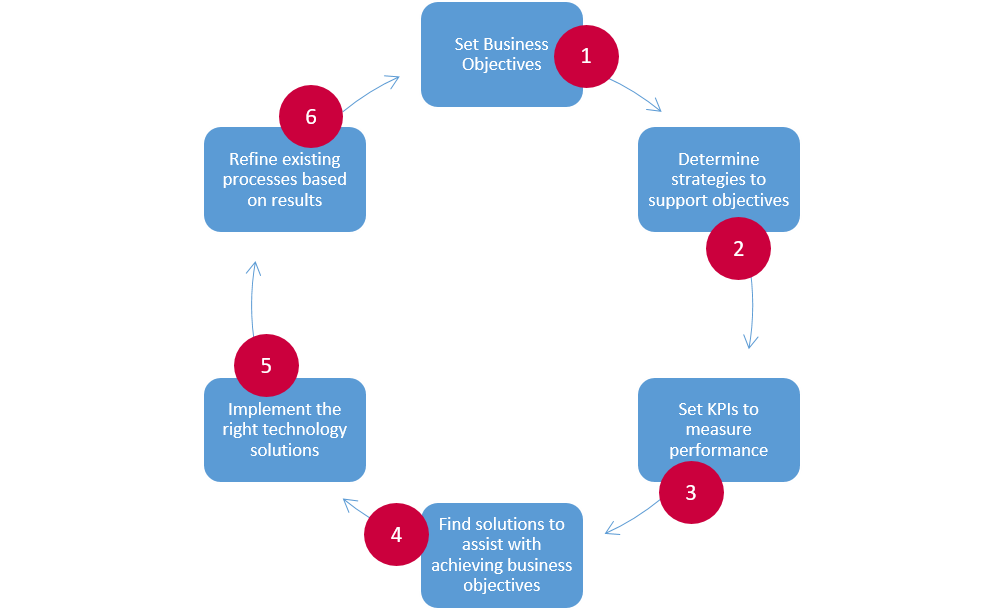Naturally, it’s easy to wait until something is broken before fixing it. For manufacturing companies looking to stay ahead of the curve in today’s highly competitive marketplace, the culture of continuous improvement is highly critical.
While most manufacturing businesses might agree on the fact that they need to have a supply chain improvement process in place, with the aim of – continuously cutting unnecessary costs, improving productivity while improving customer satisfaction – getting started on the other hand, usually gets pushed to the bottom of the to-do list.
An essential part of process improvement starts with aligning business goals with clear measurable metrics that can prove success or show areas that need improvement. As such, businesses that are truly interested in optimizing their current business processes need to employ a continuous optimization process that is circular in nature (Figure 1), and should become a core fabric of the business’ daily routine tasks instead of a one-off project that comes along every two or three years after something goes terribly wrong.
Figure 1

Looking at the diagram above, you may notice that finding the right technology solutions to help optimize your current business processes is the fourth step in the process. Many companies start the search for a new technology solution without going through the steps of setting business objectives, determining strategies, and ways to measure performance. This approach sometimes sets the business up for failed implementations or low user adoption rates as the implemented solutions may fail to align with the core business goals.
While configurable supply chain planning and optimization tools like Arkieva provide the malleability needed to easily build a solution that fits your established business processes, achieving the full business value of having a truly powerful solution comes with the need for a full commitment to process optimization starting from your core business objectives.
Read Also: A Guide to Supply Chain Management: Making Intuition More Valuable
Getting Started with Your Supply Chain Optimization
1. Setting Business Objectives
Setting business objectives is the first step to optimizing your current supply chain processes. When looking at business objectives it’s important to take a step back, to look at your business from a ‘10,000-foot view;’ meaning, this activity should not focus on specific functionalities and features. This stage is for setting core business objectives only.
Examples of business objectives include:
- Reducing inventory costs
- Reducing customer response time to increase customer satisfaction
- Increasing market share
- Reducing current distribution costs
- Reducing waste – streamlining processes
- Improving quality
- Reducing manufacturing throughput
These are only a few examples; this list should be tailored to your specific objectives.
Trending: Good Advice: Don’t Dwell in The Past
2. Determining Strategies to Support Business Objectives
Once you’ve determined your business objectives, it’s now time to determine how you will achieve the set objectives. At this part of your supply chain optimization process, you should start by looking at each set objective and determine strategies and tactics that need to be employed in order to achieve your desired results.
So for instance, looking at the objective of reducing inventory costs, you would have to determine why you have the inventory costs that you currently have. Is it a problem of inaccurate forecasts that exceed current market demand? If so, why does that exist? Perhaps it’s because you have disparate systems that don’t currently talk to each other, leading to the inability to get real-time forecasts. Or is it because there are too many manual steps involved with manipulating excel spreadsheets, making it almost impossible to have on-the-fly forecasts when needed? Once you identify the problem, it makes setting clear strategies much simpler. So in this scenario, if you identify that your inventory cost issue comes from having disparate systems, then the strategy should be to find a way to unify your systems.
3. Setting KPIs to Measure Performance
Setting KPIs to measure your performance is fundamental for determining when you are making strides towards your overall business goals or when you need to make changes. Going back to the inventory example, KPIs that could be measured include:
- Inventory to Sales Ratio
- Inventory Turnover
- Inventory Accuracy
- Back Order Rate
- Perfect Order Rate
Setting your KPIs ahead of time can also help you as you go into your solution finding stage. If you currently do not have a system that is able to give you a quick dashboard view of your KPIs, you may want to find a supply chain planning solution that comes with the ability to have inbuilt dashboards and reports.
Related Whitepaper: Improving Your Supply Chain: Where to Start?
4. Finding Solutions to Assist with Achieving Business Objectives
Going through the steps of outlining business objectives, setting strategies and KPIs, makes the solution search process less daunting. Because you go in with your core business objectives already in mind, you might not get sidetracked into getting something that your business doesn’t really need if it doesn’t align with your core business objectives. Let’s face it…some technology solutions may look nice on the outside and from the demonstration, but when it comes to creating a rollout plan that matches your set business objectives, you may find that it’s not as flexible. The pre-defined templates may not fit your already defined objectives, and processes may not be as easy to configure. Getting all your requirements from the business level down to the strategy and KPI level, allows you to ask the ‘tough’ questions early on instead of down the road when you’ve already made a commitment.
5. Implementing The Right Technology Solutions
The type of implementation and support you receive could play a vital role in your organization’s ability to successfully role out a continuous supply chain optimization process. Even with a full-staff IT team, do not underestimate the value that having a provider with the flexibility to easily personalize a solution can bring to the table. Configurability provides the scalability needed for your solution to scale with your business as your business grows. Always look at your short-term and long-term goals.
Additionally, it’s important to note that, “right” is relative. Each business is unique and in order to gain a competitive advantage, implementing a solution just because a competitor of yours has the same solution may not always be in your best interest. Sometimes, in order to stay ahead of the curve, you need to think “outside the box” and solutions that do not restrict you may be your best bet for now and the future. For more information on a successful supply chain planning implementation, this whitepaper outlines a six-step path approach.
6. Refining Existing Processes Based on Results
And, finally, as mentioned earlier the supply chain improvement should not be looked at a singular project. As you measure your performance by looking at your defined goals, there will always be things that can be further improved. Ways to streamline your processes even further and ways to improve your existing customer satisfaction. At the end of the day, if your goal is to be an industry leader or continue your reign at the top, you have to always be a step ahead with making data-driven business decisions that propel your business forward – every single day.






